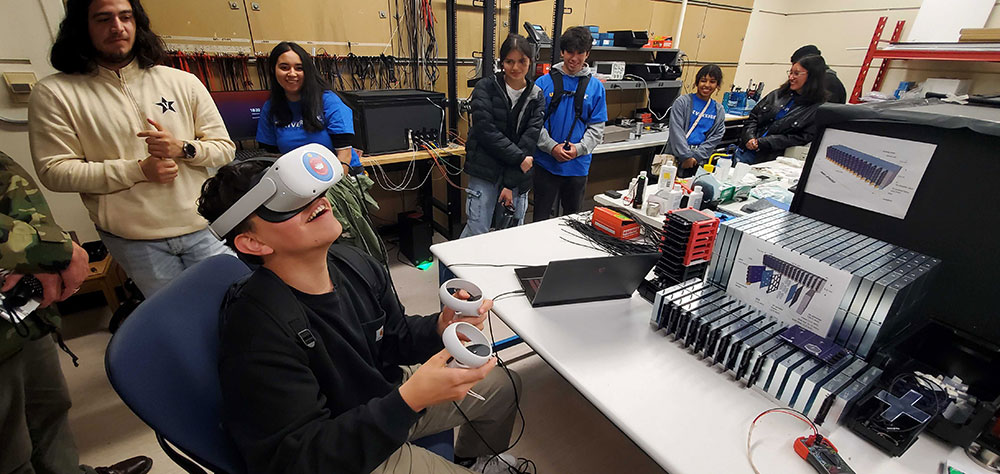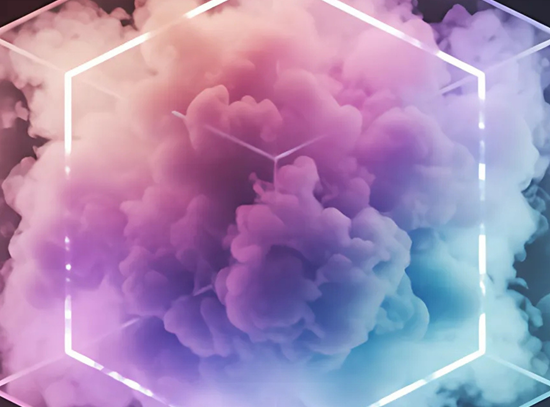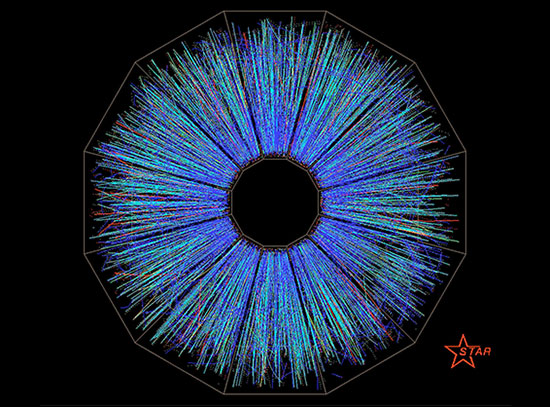Bringing the Beautiful Data of the Electron-Ion Collider to Life
Virtual reality program simulates particles streaming from collisions
March 6, 2025
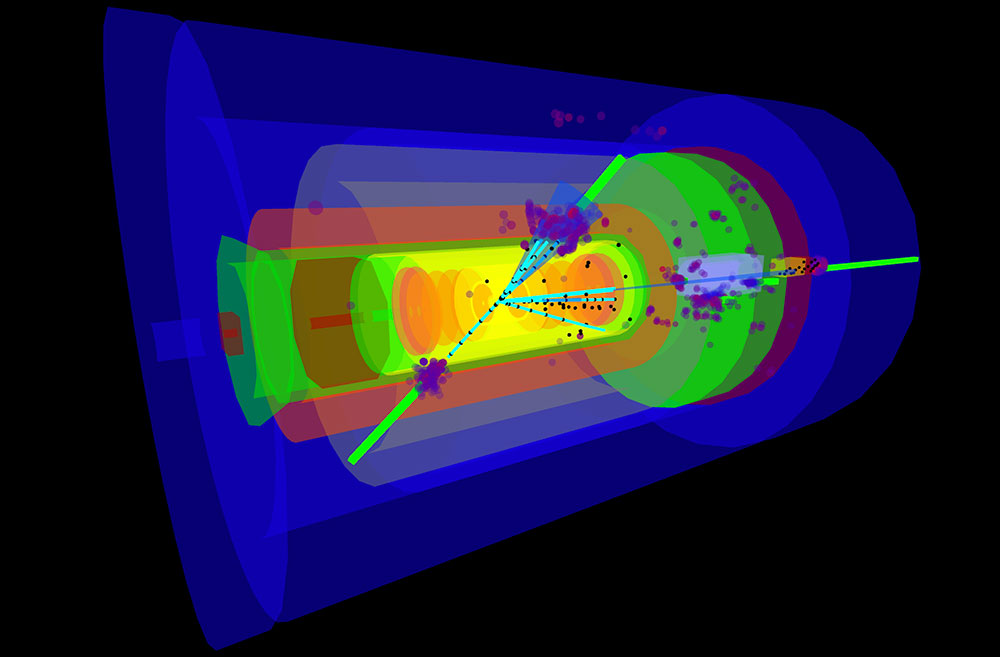 enlarge
enlarge
The EIC detector, known as ePIC, will use cutting-edge technologies to detect particles created in collisions between high energy electrons and protons or ions (the nuclei of larger atoms) moving close to the speed of light. This image from VIRTUE shows simulated particle hits and tracks. (Sean Preins/VIRTUE)
Pixels and particles collide, thanks to a pioneering student’s idea to mesh the world of video game technology with real-world physics.
Sean Preins, a doctoral student in the Department of Physics and Astronomy at the University of California, Riverside (UC Riverside), has developed a customizable virtual reality program called VIRTUE, or Virtual Interactive Reality Toolkit for Understanding the EIC, that allows users to journey into the heart of the groundbreaking Electron-Ion Collider (EIC) and explore the thrilling clash of particles in the EIC’s particle detector.
The EIC will be built at the U.S. Department of Energy’s (DOE) Brookhaven National Laboratory in partnership with DOE’s Thomas Jefferson National Accelerator Facility. Unlike any other particle collider, it will collide polarized, or spin-aligned, electrons with polarized protons and ions to investigate the innermost details of the building blocks of matter with unprecedented precision.
Even before the EIC turns on in the next decade, VIRTUE is bringing scientists’ simulated data of these subatomic particle collisions to life via 3D animations that showcase what the EIC’s house-sized detector, called ePIC, may capture.
Scientists are using VIRTUE to fine tune the detector, plan their experiments, and spark the public’s excitement about the EIC’s promise of deepening our understanding of the universe at a fundamental level.
EIC and VIRTUE: “A great opportunity”
“Not many people have tried to render what these collisions look like,” said Preins. “I decided it would be a fun project to take on, and it’s paid off in a big way.”
He first came up with the idea of marrying VR with scientific data during the COVID pandemic in 2020. His advisor, Miguel Arratia, assistant professor at UC Riverside, enthusiastically approved.
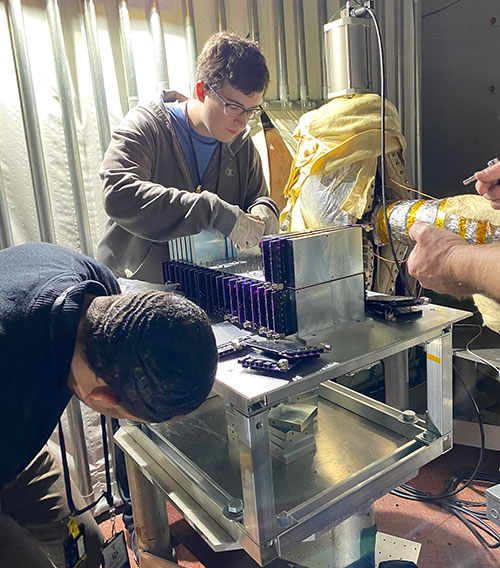 enlarge
enlarge
Sean Preins and colleague working on a detector prototype for the future Electron-Ion Collider. (UCR/Arratia lab)
“I was working from home, and Miguel sent a VR headset to my house in Illinois so I could start working on this project,” Preins said.
The EIC is related to Preins’ thesis topic at UC Riverside, where he and other students in the Arratia Research Group are developing components for the real ePIC detector, specifically the calorimeters that will measure the energy of particles produced in collisions.
Such a complex machine cannot be created in a vacuum; it requires the “hive mind” of hundreds of experts around the U.S. and the world. As members of the ePIC collaboration, a global network formed in 2022, Arratia and Preins are among a team of more than 1,500 scientists and engineers from 173 institutions in 25 countries who are helping to design and develop the EIC’s detector and its components.
Designing and building machines like the EIC can take decades. EIC construction is expected to begin in 2026 with operations starting sometime in the mid-2030s.
“The timing of the EIC project is a great opportunity for Sean,” said Arratia. “It’s the perfect opportunity to develop and propose detectors and test them in the lab.”
Preins noted, “It’s very exciting to be on the ground floor of this project as it’s in development.”
Leveraging gaming technology
Preins developed VIRTUE, which is supported by the UC Office of the President via the California EIC Consortium project, by uploading real simulation data and engineering designs by the ePIC Collaboration. He then used a software program called UNITY, commonly used to create video games, to transform data into 3D animations.
“There was a niche open for an event display for EIC collisions,” Preins said. “I took on the challenge of combining video game programming tools with simulated physics data to show what happens in these collisions,” said Preins.
He had little to no experience designing such a program.
“I taught myself how to use UNITY,” said Preins, “so throughout my development of VIRTUE, I was learning.”
But VIRTUE is not a game. It provides critical information for scientists and engineers as they design and develop the EIC detector.
“This is real information. All the hits that you see in the event displays are real information that the EIC physicists use for analysis,” said Arratia. “What is unique about VIRTUE is that it is visualizing data in all its complexities. We are not simplifying anything.”
“There will be discoveries, big discoveries”
What Arratia refers to as “hits” are energy deposits left by the particles streaming out of the collisions, caught by a series of state-of-the-art microelectronic sensors.
VIRTUE translates this data into detailed images of how the particles move through the onion-like layers of the detector.
“You have to find a way to connect all of those dots,” said Arratia. “In the VR program, you can see patterns in 3D space and time that you'd miss if it was just printing out text on a screen,” said Arratia.
Once the EIC is running, scientists like Preins and Arratia will upload actual data from millions of collisions.
“It will look very similar to what we see already in the animations,” said Arratia.
“Hopefully, there will be discoveries, big discoveries. With this tool, we’ll be able to visualize the events that are associated with that discovery,” said Arratia.
VIRTUE is also an educational tool. Users can download it for free and, either from a desktop or with a VR headset, customize the detector geometries and collision data to animate experiments beyond the EIC.
“It's really exciting to see VIRTUE used in outreach,” said Preins. “Sometimes we have lab tours with high school students. Seeing these young scientists get excited about VR and the actual research we do using this tool is very rewarding.”
Arratia added, “They see the sheer scale of things, how the data is beautiful, and they get a sense of awe.”
Brookhaven National Laboratory is supported by the Office of Science of the U.S. Department of Energy. The Office of Science is the single largest supporter of basic research in the physical sciences in the United States and is working to address some of the most pressing challenges of our time. For more information, visit science.energy.gov.
Follow @BrookhavenLab on social media. Find us on Instagram, LinkedIn, X, and Facebook.
2025-22339 | INT/EXT | Newsroom




